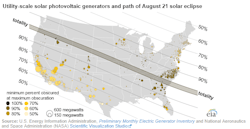Get the Microgrids Ready. A Solar Eclipse is Coming & News from EIP, Stem and CPower
Get the microgrids ready. A solar eclipse is coming
Because of their intelligent control systems, microgrids can assist in managing the intermittency of renewable energy. So get your microgrids ready when the August 21 solar eclipse occurs.
The Energy Information Administration is reporting that the eclipse will affect 1,900 utility-scale solar PV plants in the U.S.
The moon will directly block sunlight for about three minutes and less directly for about three hours.
North Carolina and Georgia are positioned to see the greatest drop in solar PV production. California will see a lot of solar PV output fall off too — just because of the sheer number of solar plants operating in the state.
The North American Electric Reliability Corporation (NERC) does not expect the eclipse to cause reliability issues for the bulk power system. This grid will rely on other generators – and perhaps local microgrids – to make up for the loss in solar output.
Microgrids, of course, also often operate with solar PV. But advanced microgrids employ multiple resources, such as energy storage, combined heat and power and natural gas generators that can supply electricity when solar panels cannot. These resources keep power flowing to the microgrid’s customers and in some cases also supply energy to the central grid.
Let us know how your microgrid functions during the eclipse, and if it provides service to the central grid. Please post your news on the Microgrid Knowledge LinkedIn group.
Alliant Energy joins utility coalition investing in microgrids, innovative energy tech
Another large utility, Alliant Energy, has joined Energy Impact Partners (EIP), a coalition of utilities investing in microgrids and other innovative energy technologies, products and business models.
The Wisconsin-based utility serves 960,000 electric and 410,000 natural gas in the Midwest and is among the S&P 500. It is participating in EIP through its non-regulated subsidiary, organized under Alliant Energy Finance.
EIP is a private equity firm that has invested in Greenlots, Advanced Microgrid Solutions and Enchanted Rock. Alliant joins more than a dozen other utilities participating in the investor group, among them National Grid, Southern Company and Xcel Energy.
Stem and CPower bring together batteries and demand response
California-based Stem and Maryland-based CPower are bringing together their know-how in battery energy storage and demand response via a new product to be offered initially in California.
The partnership will provide customers an integrated solution for managing electricity demand. The product is being marketed to commercial, industrial, and institutional customers. It brings customers a revenue stream and substantial energy savings, while at the same time alleviating stress on the grid.
“As peak demand charges rise and time-based rates become more complex, customers are looking for expert advice on how to automate energy curtailment and reduce costs,” said John Horton, CPower’s president and CEO.
The service also reduces the demand for electricity when the grid is stressed, when electricity prices are volatile, and when less-flexible generation assets cannot immediately respond.
Follow Microgrid Knowledge on Twitter @MicrogridNews.
About the Author
Elisa Wood
Editor-in-Chief
Elisa Wood is the editor and founder of EnergyChangemakers.com. She is co-founder and former editor of Microgrid Knowledge.
